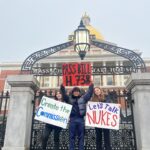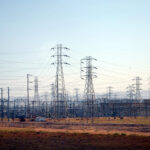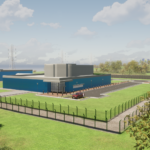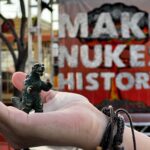Documenting Three Mile Island
By J. Samuel Walker | March 18, 2009
When the Three Mile Island accident occurred on Wednesday, March 28, 1979, I was an interested but distant observer. I had been informally offered a job as the associate historian of the U.S. Nuclear Regulatory Commission (NRC) but was still waiting for the final paperwork to be processed. I read all that I could about the accident in newspapers and magazines to try to understand, with mixed success at best, what had happened on the morning of the accident and the five days of tense uncertainty that followed. My two recurring thoughts were, “Perhaps someday I will write a history of this,” and, more unsettling, “how will I ever gain the knowledge I need to get the story right?” In 2004, I published a history of the accident that received highly favorable reviews. The publication of Three Mile Island: A Nuclear Crisis in Historical Perspective did not end my reflection on the causes and consequences of the accident, however, and three decades after my first introduction to the subject, I’m still working on Three Mile Island.
After the paperwork went through, I arrived at the NRC in June 1979. The chief historian, George T. Mazuzan, had joined the agency a year earlier. Our mandate was to publish scholarly histories of nuclear regulation. We both held PhDs in history and each of us had published a book and journal articles in our special field, U.S. diplomatic history. But we had no training or expertise in the history of nuclear power regulation. To perform our jobs, we applied the principles and methods we had learned as professional historians to a topic that was far removed from our previous research interests.
We gradually gained a command of the subject of nuclear power. Or so we hoped. After plowing through thousands of pages of documentary evidence, we were throwing around terms like “negative temperature coefficient” and “maximum permissible dose.” By 1983, we had completed a manuscript that focused on the regulatory policies of the NRC’s predecessor agency, the Atomic Energy Commission, during the 1950s and early 1960s. When acquaintances asked me what I was working on at the NRC, I did not attempt to outline the technical and legal complexities of nuclear regulation. Instead, I answered, “I’m working on the roots of Three Mile Island.”
When I finally got around to writing on TMI explicitly by 2000, after several books for the agency charting its history and becoming the NRC’s sole historian, I had only general knowledge of the accident. I vaguely remembered some of the highlights–Pennsylvania Gov. Richard Thornburgh’s advisory evacuation for pregnant women and preschool-aged children, the hydrogen bubble scare, and President Carter’s tour of the crippled plant wearing yellow booties–but I had little idea of the sequence of events during the five days of acute crisis. In approaching the subject I had two major assets. One was a mountain of evidence, even if the volume was at times intimidating. The other was more than 20 years of experience in writing the history of nuclear regulation. The knowledge I had gained as a staff historian at the NRC since 1979 made the difficulties of sorting out the technical, political, and bureaucratic morass at Three Mile Island seem manageable. The topic would have been overwhelming had I attempted to write this history shortly after arriving at the agency.
My objective in Three Mile Island was to write an accurate and comprehensive history that would serve as an authoritative resource for both the NRC and the interested public. In this book, as in the others, the agency placed no restrictions on my scholarship and gave me complete independence in deciding on structure, content, and conclusions. I planned to focus on the five days of agonizing crisis that followed the accident, but I also wanted to place Three Mile Island within the context of the debate over nuclear power in the 1970s. I opened the book with a chapter on the bitter controversy over the likelihood and consequences of a serious nuclear accident.
Most of the text provided a detailed account of the causes of the accident and the response to it by the NRC, the state of Pennsylvania, and the White House. The accident was caused by a series of minor mechanical failures that operator errors drastically compounded. Within a couple of hours, large portions of the reactor core had melted, though the fact that a massive meltdown had occurred did not become clear until 1985. The initial response to the accident by federal and state officials was halting and uncertain, largely because no one could confidently assess the condition of the reactor or estimate the risk of a large release of radiation to the environment. The information available was fragmentary and sometimes contradictory.
The greatest source of concern during the TMI crisis was a bubble that formed in the top of the pressure vessel, the large container that held the core, from the release of hydrogen during the accident. Although opinions differed, some reactor experts feared that over time the hydrogen bubble might become flammable or, less likely, explosive by combining with free oxygen in the vessel. If the bubble burned or exploded, it could rupture the pressure vessel and force the damaged reactor core into the containment building. The loss of the vessel would not make a breach of containment inevitable, but it would increase the risk of a disastrous release of radiation.
The presence of the bubble was a major source of intense anxiety for many decision makers and members of the public on the weekend after the accident. Reactor experts were not, however, concerned that the bubble might suddenly explode without warning and promptly spew radiation across the countryside. They saw the bubble as a potential problem that, at worst, could become a troubling safety issue over a matter of days. On Sunday, April 1, shortly after Carter’s visit to the plant, the NRC determined that the bubble could not become flammable or explosive because of a lack of free oxygen in the pressure vessel. This conclusion was not obvious at first, but after two days of investigation and disquieting uncertainty, it was clear by Sunday afternoon. The resolution of the bubble question ended the acute phase of the TMI crisis.
I gradually pieced the TMI story together, based on a vast collection of documents at the NRC, the papers of Governor Thornburgh and President Carter, the records of the President’s Commission on the Accident at Three Mile Island (known as the Kemeny Commission), and many personal interviews with people who responded to the accident. What I discovered was that some flagrantly erroneous myths had appeared in popular accounts, and I hoped that my book would serve, in an indirect way, as a corrective. The most grievous misconstructions were portrayals of the bubble issue that were central features of at least two books that came out shortly after the accident (in 1982) and in three television programs that were broadcast later. According to those accounts, the NRC was deeply fearful by Sunday morning that the bubble could explode at any moment and cause a massive release of radiation to the environment. They insisted that two of the NRC’s top technical experts, Roger Mattson and Victor Stello, engaged in an angry argument over the chances of an immediate explosion while President Carter’s helicopter approached the Harrisburg airport.
Daniel Martin, author of Three Mile Island: Prologue or Epilogue?, wrote that reactor experts had concluded that the hydrogen bubble “could explode and rip the entire nuclear system apart at any moment.” Mike Gray and Ira Rosen offered a similar account in The Warning: Accident at Three Mile Island. Gray later embellished this story in television interviews for PBS’s 1999 “Meltdown at Three Mile Island” and a segment of NBC’s Dateline in 2001. On the NBC program, he claimed that Mattson “was concerned that literally there could be an explosion at any moment.” The interviewer, Dennis Murphy, highlighted the alleged drama by suggesting that “you have virtually a fist fight going on [between Mattson and Stello] over whether they were going to die in the next 3–4 minutes.” A program on Three Mile Island that The History Channel first aired in 2003 suggested that the bubble was in the containment building rather than the pressure vessel, a crucial distinction. Based on that blunder, it then stated that a bubble explosion would blow the top off the containment building and “fill the air for hundreds of miles with deadly radioactive gas.”
Those presentations were egregiously inaccurate, but they seem to have taken hold. I recently had an interview in which I was asked how the NRC could allow Carter to visit the plant when it knew that the bubble was ready to explode. It would not have been difficult for the writers who told the erroneous stories to have checked them against the evidence. The NRC placed its records on TMI in the public domain shortly after the accident, and even a cursory review would have revealed that experts were not worried that the bubble could blow up at any moment and instantly blow a hole in containment. The actual response to Three Mile Island packed enough stress, uncertainty, and human drama that its entertainment value did not need to be pumped up with imaginary scenarios. Mattson and Stello indeed had an animated argument at the airport, but they disagreed about the presence of free oxygen in the pressure vessel, not about whether their deaths were imminent. The continuing prevalence of those and other myths about TMI is a humbling reminder that more people are likely to get information about the accident from watching television than from reading my book.
In the end, the Three Mile Island accident, though it caused a grave crisis, did not produce a public health disaster. In the face of a core meltdown, the pressure vessel held and the plant’s containment structure was not breached. Only tiny amounts of the most dangerous forms of volatile radiation escaped to the atmosphere. Careful epidemiological studies of a cohort of some 32,000 people who lived within a 5-mile radius of the site have shown no increased incidence in cancer that could be attributed to radiation releases from the accident. I concluded in my book that Three Mile Island suggested that during the debate of the 1970s, proponents of nuclear power had underestimated the risks of a severe accident and that nuclear critics had overstated the likely consequences.
Three Mile Island was published just before the 25th anniversary of the accident. It received more attention than my previous books, in part because of the anniversary and in part because of the innate interest in an event that many regarded as a disaster. I was gratified that reviews were overwhelmingly favorable, one in the Times Higher Education Supplement, called it a “nonfiction screenplay” that read like Truman Capote’s In Cold Blood. I was greatly pleased as well that informed reviewers across the spectrum of opinion on nuclear power applauded the book as a valuable and balanced exception to the frequently partisan literature.
As we pass the 30th year since the accident, TMI continues to attract a great deal of attention. Once again, I have been busy fielding phone calls and answering questions from interviewers. They want to know what lessons were learned and what improvements have been made. These are no longer matters of mere academic interest. The nuclear industry shows signs of a strong revival and the NRC has received its first applications for new plants since 1978.
One key reason that nuclear power has gained increased support is the industry’s vastly improved performance. The accident was a stunning blow to both the industry and the NRC. It pointed to a series of deficiencies that had to be addressed to reduce the chances of another Three Mile Island. The most glaring weaknesses were “human factors” that included senior-level management, operator training, control room design, and instrumentation. The Kemeny Commission reported to President Carter in October 1979 that the “fundamental problems” at TMI were “people-related problems and not equipment problems.” As a result, the NRC tightened its requirements on operator qualification and training. The industry introduced rigorous accreditation programs and greatly expanded the use of simulators. Control rooms and instrument panels were redesigned. Both the NRC and the industry placed much greater emphasis on the management of nuclear plants by senior executives.
Many other reforms were undertaken after Three Mile Island in the areas of communications, plant monitoring, performance evaluation, and emergency planning. The NRC and the industry sponsored research on a number of safety issues that the accident brought to the forefront, such as the causes of small-break loss-of-coolant accidents and the effects of a severe accident on plant equipment and materials.
Thirty years after Three Mile Island, the U.S. nuclear power industry can point to impressive strides in safety and performance. This is partly a result of much greater operating experience. At the time of the accident, the industry was still relatively new. Most of the 65 plants online in early 1979 had received operating licenses only, at most, a few years before. Increased operating experience gained from the approximately 100 plants that were in service after the mid-1980s provided working knowledge and data that were in far shorter supply at the time of Three Mile Island.
The reforms that the industry undertook after TMI were critical to better performance. Over a period of years, the industry benefitted from technical, operational, and managerial improvements made after the accident. The capacity factor for nuclear plants (a measure of the time a plant is generating electricity) increased from the 50-60 percent range in the 1970s to the 70 percent range a decade later to the 90 percent range by this decade. The cost of generating electricity from nuclear power fell substantially in the same period. A series of safety indicators, including the number of reactor scrams, reactor safety system actuations, safety system failures, and collective radiation exposure for plant workers, have shown consistent industry-wide improvements after the mid-1980s.
Those improvements have played a major role in winning new support for the nuclear option. But they cannot be allowed to obscure a central lesson learned from TMI–the dangers of complacency. Before the accident, nuclear experts were confident that they had solved the most important reactor safety issues. This confidence and the complacency it fostered were shattered on the morning of March 28, 1979, by the combination of management weakness, inadequate operator training, inattention to human factors, and confusing instrumentation. In recent years, there have been enough operating deficiencies to underscore the continuing need for sound safety requirements and effective implementation. Three Mile Island remains a stark reminder that the future of nuclear power depends on strong performance, careful oversight, and unrelenting vigilance.
Together, we make the world safer.
The Bulletin elevates expert voices above the noise. But as an independent nonprofit organization, our operations depend on the support of readers like you. Help us continue to deliver quality journalism that holds leaders accountable. Your support of our work at any level is important. In return, we promise our coverage will be understandable, influential, vigilant, solution-oriented, and fair-minded. Together we can make a difference.
Topics: Nuclear Energy, Opinion















